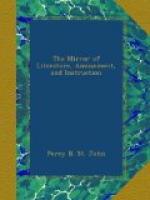In this building, an event, the most important, in its consequences, recorded in the history of any country, took place,—the marriage of Anne Boleyn, who had been created Countess of Pembroke, with the “stern Harry.” The precise period of these nuptials, owing to the secrecy with which they were performed, is involved in considerable obscurity, and has given rise to innumerable controversies among historians; the question not being even to this hour satisfactorily decided as to whether they were solemnized in the month of November, 1532, or in that of January, 1533. Hall,[4] Holinshed,[5] and Grafton, whose authority several of our more modern historians[6] have followed, place it on the 14th of November, 1532, the Feast Day of St. Erkenwald; but Stow[7] informs us, that it was celebrated on the 25th of January 1533; and his assertion bears considerable weight, being corroborated by a letter from Archbishop Cranmer, dated “the xvij daye of June,” 1533, from his “manor of Croydon,” to Hawkyns, the embassador at the emperor’s court. In this letter the prelate says, “she was marid muche about St. Paules daye last, as the condicion thereof dothe well appere by reason she ys now sumwhat bygg with chylde."[8] This statement, coming as it does from so authentic a source, and coinciding with the accounts of Stow, Wyatt,[9] and Godwin[10] may, we think, be regarded as the most correct. Her marriage was not made known until the following Easter, when it was publicly proclaimed, and preparations made for her coronation, which was conducted with extraordinary magnificence in Whitsuntide. Her becoming pregnant soon after her marriage “gave great satisfaction to the king, and was regarded by the people as a strong proof of the queen’s former modesty and virtue."[11] This latter circumstance, however, has not met with that consideration among historians which it appears to merit; for we must remember that Elizabeth was born on the 7th of the following September, an event, which would perhaps rather tend to confirm the opinion of Hall, in contradiction to that of Stow, if, indeed, Anne had been proof against the advances of Henry, previous to their marriage, which some writers have doubted.
[4] Hall’s “Chronicle,” p. 794. edit. 1809.
[5] Holinshed says, “he
married priuilie the Lady Anne Bullougne
the
same daie, being the 14th daie of Nouember,
and the feast
daie
of Saint Erkenwald; which marriage was kept so secret,
that
verie
few knew it till Easter next insuing, when it was perceiued
that
she was with child.”—“Chronicles,”
vol. iii. p. 929. edit.
1587.
[6] Hume and Henry place the
marriage in November. Lingard and
Sharon
Turner in January.




